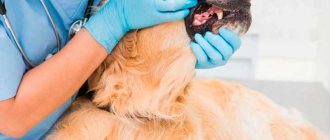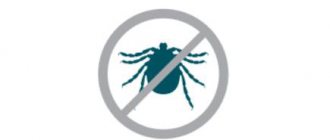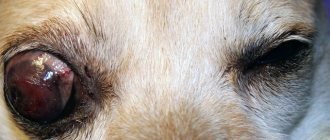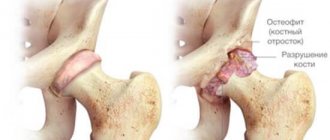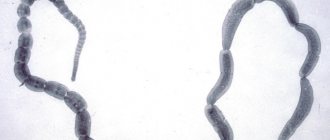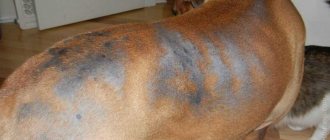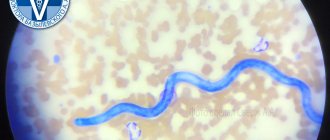Helminthic diseases in dogs, even domestic ones, are not uncommon. And in fact: is it possible to guarantee the “purity” of your pet if an ordinary flea can lead to infection? With the help of these parasites, dipylidia spreads. In dogs, this disease of parasitic etiology is quite common, and therefore it will be useful for every breeder to know about its signs and the process of development of the pathogen.
Symptoms of cucumber tapeworm in dogs
The dog’s body may not be able to cope with them, reacting with allergic manifestations. Puppies experience worse the presence of this tapeworm in the body. Naturally, characteristic symptoms appear that indicate the presence of this worm:
- Attacks of vomiting - the dog begins to vomit, its health noticeably worsens.
- Stool disorders - cucumber tapeworm can cause both diarrhea and constipation, which equally negatively affects the condition of the animal.
- The gastrointestinal tract organs cease to function fully; this occurs due to the accumulation of feces (if the invasion is accompanied by constipation), as well as the presence of several helminths in the small intestine.
- The dog becomes lethargic, does not want to play, refuses to eat, even the most delicious food, which it previously ate with pleasure.
- The animal becomes aggressive or irritated. Unconditional anger appears.
- Puppies are stunted, become emaciated and thin.
If the owner notices that something is wrong with his pet, the condition is similar to the symptoms described, he should immediately contact a veterinarian for appropriate help. Self-treatment may not bring the desired results, since the owners cannot know for sure which worm is affecting their household.
Treatment of dogs
The cucumber tapeworm is very dangerous for the animal's body; it does not even pose such a danger to humans. A dog should be treated comprehensively if it is affected by this helminth. Tapeworm leads to a deterioration in the dog’s general condition and a decrease in its body’s resistance, so the animal’s immune system should be supported.
The main medications that are used when dogs are infected with cucumber tapeworm include:
- Drontal Plus is a medicine in tablets whose active ingredient is praziquantel. The drug is administered once, it must be calculated depending on the weight of the animal: 1 tablet per 10 kg. How to get a dog to swallow a pill? To do this, it is better to crush it and add it to the food, but in this case you need to make sure that the animal eats the entire dose. Or put the tablets in sausage or meat, something that your pet will immediately swallow. The average price for the drug is 750 rubles.
- Kanikquantel – the same active ingredient with the addition of fenbendazole. The drug causes paralysis of the nervous system, so that the parasite cannot cling to the intestinal walls and is passed out in the feces. It is better to give the tablets before morning feeding on the root of the tongue in a piece of something tasty. 1 tablet per 10 kilograms of animal weight is also used. It is used from 3 weeks of age. After a course of therapy, it is better to repeat deworming a month later. 12 tablets of the drug cost an average of 1,450 rubles.
- Azinox - contains nilverm and praziquantel. Apply 0.55 g of medicine per 10 kg of animal weight, that is, 1 tablet. Can be used once. This is a low-toxic drug that can be used by dogs of all ages. Contraindication is the period of gestation of puppies and 10 days after birth.
These are the main drugs for combating cucumber tapeworm in dogs.
To prevent this parasite from entering the body of a pet, it is important to monitor its hygiene - timely treatment for fleas and use of anti-tick products. After all, they carry the eggs of this helminth. Also, for preventive purposes, deworming should be carried out every 3 months.
After preventive measures, it is important to clean the area where the animal lives: sterilize bedding, feeders and patches where their waste may be. After every six months it is better to replace them with new ones. It is also important to periodically show the animal to a veterinarian, who will conduct the necessary diagnostics and prescribe appropriate treatment, if necessary.
Symptoms
If a cat has a large number of cucumber tapeworms, the following clinical manifestations are observed:
- Oppression.
- Anemia of the mucous membranes and sclera.
- Tearing.
- "Acute belly."
- Digestive disorder.
- Half-fainting state.
- Seizures.
- Tousled fur.
- Nausea.
- Gluttony.
- Copious salivation.
- Diarrhea gives way to constipation.
- Nervous excitement.
- Cachexia.
Cucumber tapeworm is dangerous for kittens, even fatal.
Treatment
Dipilidiosis is diagnosed by microscopy of helminth eggs isolated from cat feces using a saturated NaCl solution using the Fulleborn method and a set of clinical symptoms. The treatment strategy includes the following steps:
Rules for the use of anthelmintic drugs for cats require compliance with the following restrictions:
- Do not deworm in the following cases:
- The kittens were less than three weeks old.
- Pregnancy.
- The first three weeks of lactation.
Deworming cannot be carried out if the animal is exhausted.
Medicines in tablet form are prohibited from being given to kittens and animals under half a kilogram in weight. The best form of anthelmintic is a suspension: it is easy to inject into an animal from a syringe without a needle, and convenient to dose. It is recommended to use single-use medications to avoid creating stressful situations. Deworming is repeated after 2…3 weeks.
Feeding tablets poses a certain difficulty. They use force or deception. Before processing, in order to avoid problems, fasting is necessary. The cat is securely restrained, the tablet is placed on the base of the tongue, and the medicine is observed to be absorbed. Cunning cats spit out an unpleasant-tasting object.
To rid an animal of diphyllobothria, the following anthelmintics are convenient:
- Trontsil K.
- Praziquantell.
- Kanikquantell.
- Azinox.
- Dironet.
- Polyvercane in the shape of sugar cubes.
Complex drops on the withers “Profender” or “Inspector” are convenient because they act against helminths and fleas.
To prevent complications, after treatment with anthelmintics, it is useful to give the animal a sorbent that can inactivate toxins - Polyphepan or Enterosgel. A preventive injection of an immunomodulator - immunofan, maxigan or gamavit - will not harm.
The main causes of intoxication after deworming are the decomposition of worms inside the animal. Poisoning can be caused by an overdose, the use of an anthelmintic for an adult in a kitten, or intolerance to the ingredients.
In this situation, pre-prepared detoxification drugs help:
- Immunofan and Maksigan Gamavit are administered subcutaneously.
- Orally, if there is no vomiting, sorbents are prescribed - polysorb or enterosgel.
- After the symptoms of intoxication disappear, digestion is restored with probiotics. These are active microorganisms of the normal flora of the large intestine that perform the following functions:
- Maintaining optimal PH.
- Destruction of putrefactive bacteria.
- Synthesis of vitamins - K and B 12.
Live probiotic microorganisms prevent diarrhea and stimulate the formation of immunocompetent cells. The biological supplements Bifitrilak and Vetom have remained popular on the market for a long time.
Treatment of dipylidia in pregnant, lactating and kittens
In order not to harm future offspring, the cucumber tapeworm can only be expelled in the last third of pregnancy, 40 days after mating. Lactation is also not the best time for deworming. If an anthelmintic enters the baby's body through milk, it can cause intoxication. The bans are lifted when the offspring turn 21 days old.
Prevention of dipylidia consists of the following actions:
- Pest control.
- Systematic disinfection of the tray.
- Quarterly deworming of all animals at the same time.
Pathogen
Cucumber tapeworm (lat. Dipylidium caninum)
Cucumber tapeworm (lat. D. Caninum) belongs to tapeworms (cestodes), reaches up to 50 cm in length and 3 mm in width. The eggs of the parasite are released in the feces of the definitive host (humans, cats, dogs and other carnivores), and they are ingested by fleas or lice eaters. Cystecercoids develop in the body of intermediate hosts.
One flea can have about ten cysticercoids (larvae of the causative agent of dipylidia). At this stage, the parasite becomes infectious to the definitive host.
The lifespan of the cucumber tapeworm in the body of the definitive host is no more than a year.
Ways of infection with dipylidia
Basically, dogs, foxes, wolves, jackals, as well as most cats suffer from dipilidia. A person most often becomes an accidental carrier of the disease.
In addition, infection occurs through consumption of contaminated meat, vegetables or plants. Fleas and lice eaters are the final hosts of the cucumber tapeworm.
Humans do not become infected directly from infected animals.
Pets whose owners regularly deworm their pets, buy flea collars, and keep their pets clean are less susceptible to infection than stray cats and dogs.
- general exhaustion;
- vomiting not associated with food intake;
- dysfunction of the digestive system;
- lack of appetite;
- a disorder of the nervous system, manifested in insomnia, general fatigue and disability;
- pale appearance of the skin;
- itching sensation around the anus;
- an increase in the volume of the abdominal cavity, with bulging of the peritoneum;
- sudden weight loss due to lack of appetite.
The reaction of each organism to cucumber tapeworm infection is individual and depends on the strength of the immune system, respectively, on the strength of the immune response. In some cases, both in humans and in cats and dogs, all symptoms may appear simultaneously, while the body with a strong immune system will independently fight the manifestations of the disease, avoiding toxic shock and making it impossible to diagnose the disease, given main symptoms.
If signs of the disease appear that are similar in symptomatic picture to infection with dipilidia, you should immediately seek help from a qualified specialist.
What to do if you have tapeworm?
Tapeworms, cestodes, or tapeworms are parasitic tapeworms belonging to the type of flatworms of the Tenididae family. There are several types of cestodes:
Have you been trying to get rid of PARASITES for many years?
Head of the Institute: “You will be amazed at how easy it is to get rid of parasites by taking every day...
Read more "
- Bovine unarmed tapeworm;
- Pork tapeworm;
- Cucumber tapeworm;
- Dwarf tapeworm.
All of them parasitize in the intestinal lumen of carnivorous mammals, including humans, who are the intermediate host for the tapeworm. The formation of the helminth into an adult occurs in the intestinal lumen. Numerous photos of tapeworms are posted on thematic forums devoted to the problems of infection with cystodes.
The most common types of tape parasites are pork and bovine tapeworms. As a species, the dwarf tapeworm is practically not common in our latitudes. His photos can be found on the Internet. Mainly small predators are susceptible to infection with the cucumber tapeworm. Cucumber tapeworm mainly affects dogs and cats, and the eggs are carried by fleas and lice eaters.
Bull unarmed tapeworm
Flat, interconnected segments - segments attached to the base of the head - form the body of the tapeworm. In some representatives of adult cystodes of this species, the body length can reach 10 meters, and the number of segments can reach up to a thousand. The reproductive system begins from the 200th segment. They contain eggs. As the eggs mature, the last segment separates from the body and comes out with the feces. The segment has the ability to independently move in space.
Further development occurs in the ground cover, where the fertilized eggs are ingested by cattle. Finns are formed in their stomach, which can enter the human body after poor-quality heat treatment of meat products. Photos of thematic forums show what Finns look like.
Also, bovine tapeworm proglottids enter the human body from contaminated water bodies and as a result of non-compliance with personal hygiene rules. They cause a disease such as Teniarinhoz. The lifespan of the parasite in the human body in the absence of treatment is about 20 years. During its life, a bull tapeworm produces up to a million eggs.
The symptoms of a bovine tapeworm infection are ambiguous and do not always manifest themselves. The main characteristic of the parasite is that its segments can move independently and crawl out of the human anus.
When infected with a bovine tapeworm, scattered pain in the abdominal area, nausea accompanied by vomiting, and a complete lack of appetite may occur. The tapeworm carries symptoms that are of an increasing nature and gradual manifestation of signs of the disease.
Teniarinhoz can be diagnosed only by microbiological examination of stool. Treatment is carried out in a hospital, since it involves the use of highly toxic drugs that are very effective in their therapeutic effect on the parasite.
Pig armed tapeworm
Unlike the bovine tapeworm, the head of the pork tapeworm is crowned with hooks, with which it is secured in the intestines of the owner, as shown in the photo. It is significantly shorter than its counterpart and reaches a length of no more than three meters. Man is an intermediate host. Infection with the parasite leads to the development of Taeniasis, a disease in which the human intestine is affected by an adult pig tapeworm. If there is a larval form of the parasite in the human body, it contributes to the development of cysticircosis.
In humans, tapeworm parasitizes not only in the intestines. It is dangerous because a sexually mature individual, having established itself in the intestinal lumen, produces larvae in all organs of the human body. A disease of pigs that affects humans leads to the development of Taeniasis. It is transmitted by human consumption of poorly cooked pig meat. The main difference between a pork tapeworm and a bovine tapeworm is its segments, which are motionless.
Signs of cysticercosis manifest themselves symptomatically. They appear in those organs of the human body that are affected by the tapeworm:
- Severe headache accompanied by nausea, vomiting, convulsions and impaired motor function may indicate that the helminth has affected the brain.
- Deterioration of visual function with continuous separation of tears, inflamed eyelids, conjunctiva, and retina indicate that the helminth has attacked the visual organ.
- The absence of symptoms is possible only if the tapeworm affects soft tissues, muscles, subcutaneous tissue and skin.
In some clinical cases, two forms of the disease develop simultaneously. The only type of treatment for cysticercosis is the surgical removal of helminths from the human body.
Cucumber tapeworm
This type of helminth in cats is dangerous and can manifest itself in people. The parasite's body segments resemble cucumber seeds attached to each other. Zoo forums provide multiple photos showing the appearance of the cucumber tapeworm.
The body length of the tapeworm in the intestines of cats can reach one and a half meters. The body color of the tapeworm is white or slightly pinkish.
The head of the cucumber tapeworm is equipped with hooks with suction cups. Along the body are the genital organs, which have a dual function. As they mature, the segments break off and leave the cat's body in the feces. The photo from under a microscope perfectly shows the eggs of the parasite, 0.03 mm in size.
The purpose of cats for helminths is the main, or definitive host. Lice eaters and fleas are temporary or intermediate hosts.
In cats, the main symptoms of the disease Dipylidia, caused by cucumber tapeworm, is a severe disturbance of the digestive process. The photo clearly shows how exhausted the cat is during the course of the disease. Cats also experience a nervous breakdown caused by strong psychological arousal. Zoologists believe that cats may experience hallucinations as a result of the disease.
Dipylidiasis in cats is diagnosed in veterinary clinics using the Fulleborn method. The photo shows what cucumber tapeworm segments look like in feces.
You will be surprised how many parasites will come out if you drink a glass of regular...
Parasites will leave the body in 3 days! You just need to drink on an empty stomach...
Treatment of the disease is carried out using a complex method using veterinary anthelmintic drugs.
Traditional methods for treating tapeworms
Antihelminthic folk methods offer a large number of natural remedies, which include natural products. These are garlic mash with milk, which are used both as the contents of enemas, and, prepared using a special method, as a means of drinking. Traditional unroasted pumpkin seeds, ground into powder and consumed with vegetable oil, honey, just water or on their own.
But when affected by tapeworm, the photo of which is presented here, from the point of view of doctors, folk remedies are ineffective. In case of severe invasion, only surgical intervention is indicated.
In conclusion, it should be said that a positive result of treatment can be said only after three months of regular stool examinations for the content of parasite segments, when the indicators for the presence of helminths all turn out to be negative.
Author: Voitenko A.
Bovine tapeworm is a parasite that affects the human body when it enters the body. The disease has a medical term - teniarhynchosis. Where does bovine tapeworm come from, how can you get infected? To answer this question, you should know the development cycle and possible routes of entry into the body of the parasite.
Life cycle of a parasite
Bovine tapeworm begins its development from the feces of an infected organism, which ends up on the grass or soil along with the eggs. The latter lose their shell in the external environment and transform into oncospheres. They are resistant to weather conditions; even low air temperatures and snow cannot localize them.
Oncospheres enter the body of cattle along with grass. At this point in the stomach they begin to enter the Finn stage. The duration of this stage of development reaches 6 months. Finns are very mobile by nature, which helps them spread throughout the body of the intermediate host.
When beef contaminated by Finns enters the human stomach, they enter the final stage of their life cycle - developing into an adult. After this individual begins to lay eggs, the development cycle repeats. This is where the tapeworm comes from.
Reasons for the development of teniarinhoz
The body of the bovine tapeworm consists of a head, neck and segments. The segments have reproductive capacity. There are about 1000 of them on the body of an adult. Each has 150 eggs inside, so the tapeworm lays about 150,000 eggs per day. They are excreted from the body along with feces. From this it becomes clear how the egg emerges for further development.
The head of the tapeworm is equipped with suction cups, with which it is firmly fixed in the intestine. An adult can only be removed from the body with the help of medications. The human body is a comfortable environment for the parasite to live. It can exist in it for about 20 years.
Symptoms
This disease is asymptomatic in the initial stages, so it is difficult to identify. As the bovine tapeworm grows in the body, the following signs appear:
- pain in the abdominal cavity;
- increased appetite;
- insomnia;
- itching in the anal area;
- irritability;
- fast fatiguability.
Important! You should pay attention to your health condition and consult a doctor!
The destructive effect of the parasite
The vital activity of the bovine tapeworm endangers human health. Its presence can lead to the following consequences:
- Disruption of the gastrointestinal tract, as well as inflammation of the mucous membrane.
- Pain in the abdominal cavity.
- Intestinal obstruction, which leads to constipation.
- Immune system disorder.
- The appearance of rashes on the skin, changes in its color.
Since bovine tapeworm exists due to the beneficial substances of the human body, weakened immunity leads to many concomitant diseases, constant fatigue, and sleep disturbances.
Diagnostics
How to detect a bull tapeworm if certain ailments appear? To diagnose a parasite in the body, you should consult a specialist. Methods for detecting the disease:
- detailed interview and examination of the patient;
- examination of feces in the laboratory;
- general blood test to detect the inflammatory process;
- X-ray examination of the intestine.
Based on these studies, the doctor can make a diagnosis.
Important to remember! Diagnosis and treatment at home is dangerous! After all, they may be erroneous, which will negatively affect your health.
Complications of the disease
Incorrect treatment or ignoring teniarhynchosis can lead to the following consequences:
- intestinal obstruction due to blockage of part of the intestine by tapeworm and its waste products;
- destruction of the intestinal walls, which leads to peritonitis;
- inflammatory processes – appendicitis, cholecystitis, pancreatitis;
- atypical location of the worm, which leads to poor performance of the organ.
Important! You need to monitor your health and periodically undergo preventive examinations! Bull tapeworm may not cause discomfort for a long period.
Methods of infection
There are several ways in which bovine tapeworm begins to develop in humans:
- Pets. This parasite is often found in cats and dogs, which can infect their owners.
- In fish and meat. Purchasing these products on spontaneous markets does not guarantee their quality. Bovine tapeworm eggs are difficult to see in products.
- Eating raw meat. Meat products may contain parasite eggs, which, along with food intake, will enter the stomach and begin their development.
- Weak heat treatment of beef. In order to protect your body from ingestion of bovine tapeworm, you should prepare meat dishes with high quality.
- Poorly washed board and knife after cutting meat. In this case, the tapeworm may spread to other products that must be cut with these devices.
Important! Not a single person is immune from damage to the body by bovine tapeworm! Therefore, precautionary measures should be taken.
Prevention
Preventive measures are based on the methods of infection by the parasite. Therefore, you should adhere to the following rules:
- vaccination of domestic animals, as well as preventive administration of antiparasitic drugs during the warm season;
- purchasing beef from retail outlets with quality certificates;
- proper heat treatment of meat products;
- processing the knife and board after cutting meat;
- limiting the consumption of raw meat;
- minimizing contact with the patient.
You should also follow basic hygiene rules (washing hands) and sanitary standards and teach your children this. If a family member living in the same house is sick with taeniarinhoz, you need to thoroughly clean it using disinfectants. During this period, the patient must change bed and underwear daily.
How to determine dipylidia
The only reason to confirm the diagnosis of cucumber tapeworm is a positive stool test to detect worm eggs. In modern laboratories equipped with powerful microscopes and reagents, today research is carried out quickly and efficiently. But it is believed that the Fulleborn method is the most effective for identifying cucumber tapeworm.
The essence of the method is to treat feces with a sodium chloride solution, as a result of which, during centrifugation, worm eggs, light in specific gravity, come to the surface, easily diagnosed, as in the photo.
How to treat cucumber tapeworm
Regardless of who is diagnosed with the disease: in cats, dogs or people, treatment is prescribed based on the drug fenasal, drontal, quaniquantel, azinox and others.
In each individual case, the dosage is selected separately. For cats, the dosage will be less than for dogs only because these animals are much smaller in size and, accordingly, in weight.
A liquid, low-fat diet is recommended for people, cats, and dogs while taking anthelmintic medications to eliminate cucumber tapeworm. Take the recommended daily dose of the drug at a time before the first meal. A couple of hours after taking the drug, take a salt-based laxative. Salt is an irritant to the mucous membrane of the epithelial layer of the intestine, to which the cucumber tapeworm is attached.
During therapy in humans, cats and dogs, a second course is prescribed a month after the main course. During this period, the remaining helminth eggs mature. When repeating the course, laxatives are not prescribed as an accompanying treatment.
After treating cats and dogs with insecticidal preparations, it is better to put a collar on the animal that prevents the appearance of fleas and ticks.
How to avoid getting infected with cucumber tapeworm
The first and only way to avoid infection with dipylidia is disease prevention. If there are pets in the house, they should have their own sleeping places, and cats should have a litter box.
Our health is in our hands. If there is an animal in the house, then regular examinations by a veterinarian are the key not only to its health, but also to the well-being of all family members.
The cucumber tapeworm is a fairly large helminth; it can reach 30-70 centimeters in length, while its width does not exceed 3-5 millimeters. The body of the cucumber tapeworm is grayish-white or light pinkish in color, consists of many segments (look at the photo), the scolex (head part). On the scolex there are four suckers and four rows of hooks, with the help of which the helminth is attached to the intestinal mucosa in dogs.
At the anterior end of the body of the cucumber tapeworm there are immature segments, the middle section of the strobila contains segments with hermaphroditic genital organs, towards the end of the body the segments are thickened and already contain cocoons with eggs. The eggs look like cucumber seeds, which is where cestodes get their name.
Danger level for humans: can you get infected from a sick dog?
Unlike the same roundworms or trematodes (they are also “liver flukes”), many common types of flatworms are, to one degree or another, dangerous to humans. Simply put, a sick pet is a threat to the owner and his entire family. But it's not all bad. For example, many dog breeders are interested in whether it is possible to become infected with cucumber tapeworm?
The answer is twofold. On the one hand, this is quite real. On the other hand, this is not so easy to do. The fact is that the larvae of this cestode (like the larvae of many other parasites) need to mature in the body of an intermediate host. In this case, it is a flea.
Dogs become infected by gnawing bloodsuckers out of their fur. Interestingly, infected fleas become lethargic and inactive, which several times increases the likelihood of them being swallowed by a dog.
If the owner does not add fleas to his food, he is not in danger of becoming infected... However, small children who put everything in their mouth can easily become infected.
Again, borage often does not live long in the body of an adult, since it is suppressed by the immune system (this type of tapeworm is not adapted to life in the human body). But in the intestines of a child, the cestode can grow to a decent size, simultaneously causing the development of quite severe symptoms .
But not everything is so good. For such types of cestodes as echinococci, alveococci and bovine tapeworms, humans are not only the final host, but also the intermediate host.
This means that eggs that enter the human body hatch into larvae. They break through the intestinal wall, penetrate the local blood vessels, and then spread throughout the body through the bloodstream. The problem is that young “embryos” of parasites can end up in any place, including the heart and even the brain.
In these tissues they “pupate”, after which they form a cyst filled with young scolex of parasites, each of which is a potential worm. During the process of growth, these neoplasms strongly compress the surrounding tissues, interfering with their normal nutrition and innervation, as a result of which even the sudden death of an infected person is quite possible.
Life cycle of tapeworm
The cucumber tapeworm develops with a change of two hosts. The main hosts are carnivores, with fleas and canine hairworms being intermediate, which is why the disease is so often diagnosed in dogs.
The life cycle of the cucumber tapeworm begins from the moment when the invasive finna (larval stage) of the helminth enters the gastrointestinal tract of its final host. In his body, the tapeworm develops within 15-21 days until the stage of puberty. Next, the separation of mature segments with eggs from the strobila begins. Together with the feces of dogs or other animals, they go out into the external environment, where they continue their development.
The segments end up on the dog's coat, bedding, and toys. Tapeworm eggs are eaten by flea larvae. When a flea larva becomes a pupa, tapeworm eggs also develop in its body. Already in the body of an adult flea, the cucumber tapeworm reaches the invasive stage.
Infection of the definitive host occurs when fleas and lice eaters are eaten. Infection of a puppy can occur during the period of feeding with mother's milk. The lifespan of a tapeworm in dogs ranges from several months to one year.
Tapeworm species Taenia
There are nine main types of these parasites, but usually only seven of them cause disease in dogs and other domestic animals.
The route of infection is nutritional , that is, the dog must eat the intermediate host of the worm. If a dog simply swallows food contaminated with “immature” eggs, infection will not occur; the embryos will be successfully digested. In the body of the intermediate host, a larva hatches, which immediately “colonizes” many of its organs and tissues, and its encapsulation occurs.
But! The “capsule” of all cestodes is not a connective tissue membrane like that of roundworms, for example, but a kind of sac. And the purpose of the larva is to grow and divide, forming inside this cavity many scolex (heads) of future worms. This is also an evolutionary adaptation. Some of the scolex will inevitably die in the digestive tract of the final host. The more there are, the higher the parasite’s chances of survival of the species.
Symptoms and diagnosis
What are the symptoms of these cestodiases? As a rule, they almost never happen. Only in severe cases does the dog quickly lose weight, the condition of its coat and skin deteriorates sharply, and edema and congestion may occur (up to pulmonary edema and death from suffocation). If the worm is particularly “well-fed”, or there are several individuals in the dog’s intestines, intestinal obstruction . So often the only reliable sign is the detection of severed segments in the stool.
How will a veterinarian understand what exactly your pet is sick with? The only reliable method is to conduct a microscopic analysis of stool. During this process, cestode eggs are discovered. If the specialist is experienced enough, then by their appearance he will be able to find out what kind of parasite is in the dog’s body. However, this is practically unrealistic, since the eggs of all shadows are almost identical.
Treatment of tapeworms in dogs
How are these pathologies treated? Fortunately, all Taenia species are quite susceptible to many anthelmintic drugs. In particular, cheap Drontal .
Prevention methods should be based on preventing dogs from eating raw meat or offal. If you live in a private house, regularly carry out deratization and, if possible, keep the dog in an enclosure. This is necessary to prevent it from hunting rodents. If you received offal for free or at too low a price, take the time and take the sample to a veterinary clinic. It is possible that the too attractive price of the food is due to its complete unsuitability for feeding dogs.
Clinical picture
The clinical picture of the disease caused by cucumber tapeworm in dogs is manifested by the following symptoms:
- Attacks of vomiting and bowel movements (the dog may also experience diarrhea).
- Stagnation of contents in the intestines, and the helminths themselves can form clusters, which interferes with the full functioning of the gastrointestinal tract.
- General depressed state: apathy, reluctance to play, lethargy, refusal to feed.
- Nervousness.
If the invasion affects the puppy, then there may be a lag in growth and development, decreased immunity, and exhaustion.
If you notice similar symptoms in dogs, you should immediately contact your veterinarian. You cannot independently treat a dog, since it is not possible to determine the type of helminth without certain research and knowledge; inappropriate treatment can only cause harm to your pet.
Drugs
If dipylidiasis is observed in dogs, then they need complex therapy. Initially, animals must be given medicinal anthelmintic drugs, the action of which is aimed at eliminating helminths.
In most cases, treatment is carried out with Drontal, Parasiticide, Melbemax. After treatment, it is necessary to examine the dogs' feces. If the need arises, then the animal is re-treated.
After the main treatment, patients are prescribed immunomodulatory therapy. Animals also need to be given antibacterial treatment. With its help, the pathogenic microflora that accompanies cucumber tapeworm in dogs is eliminated.
Dogs should be given subcutaneous infusions and drips if they become dehydrated or lack appetite. In order to restore the mucous membrane of the intestinal tract, it is necessary to use special medications. In order to eliminate the possibility of microbial proliferation, antiprotozoal drugs are used.
Dipylidiasis requires treatment in dogs using drug therapy; it is a rather dangerous disease. To avoid its occurrence, it is necessary to carry out timely prevention.
Diagnostic measures
Before prescribing adequate treatment, the veterinarian must carry out the necessary diagnostic measures, which mainly consist of analyzing the clinical picture and helminthoscopy.
The helminthoscopy procedure involves the detection of cucumber tapeworm segments in the feces of dogs. To carry out this analysis, fresh stool samples are used. The procedure can be repeated, since the helminth does not release its segments every time the animal defecates. When the first negative result (usually a false negative) is obtained, the test is carried out two to three more times.
Establishing an accurate diagnosis allows you to prescribe the correct treatment for the infested dog. All drugs for drug therapy are selected taking into account the individual characteristics of the shaggy patient’s body.
Test for dipylidiasis
The owner can determine the presence of cucumber tapeworm in a dog’s body without laboratory tests. To do this, it is enough to examine the animal’s feces using a strong magnifying glass. In them you can find segments of the parasite, similar to small cucumber seeds.
To check, stool particles can be dipped into a slightly warmed saline solution. Under such conditions, the segments contract and eggs of the cucumber tapeworm are released.
Parasitologists determine the type of pathogen by their appearance. If an animal dies, helminths can be identified by autopsy and examination of the intestines.
For laboratory diagnosis of dipylidia in dogs, the following is carried out:
- blood chemistry;
- general blood analysis;
- general urine analysis.
In addition, microscopic examination of stool is prescribed. Cucumber tapeworm eggs are found in them.
Treatment of cucumber tapeworm
Below is a treatment regimen for cucumber tapeworm in dogs:
- Basic deworming. The destruction of helminths is carried out using special anthelmintic drugs (Prazid, Drontal, Melbemax and others). The medication can be taken 2-3 times, the interval between treatments is usually from seven to ten days. After deworming, fresh stool samples are examined and treatment is repeated if necessary.
- Antibacterial therapy for dogs. Treatment with antibacterial drugs is carried out to suppress and eliminate the attached pathogenic microflora.
- Treatment with antiprotozoal drugs. Antiprotozoal agents are necessary to prevent the proliferation of protozoan microbes, for example, Giardia.
- Therapy with special drugs to restore the mucous membrane of the gastrointestinal tract.
- Taking subcutaneous or drip infusions if the dog has no appetite or is dehydrated.
- Immunomodulatory therapy after primary treatment.
source
The disease teniarhynchosis, caused by a helminth called bovine tapeworm, brings a lot of troubles and health problems. Localized in the intestines, the worm leads to disruption of its functioning, as a result of which the patient suffers from abdominal pain and problems with stool. What is a bovine helminth, what types of worms are there, how to identify a helminth, and what kind of treatment is indicated when the diagnosis is confirmed?
What does it represent?
The bovine tapeworm in humans grows and develops almost asymptomatically, an adult grows up to 10 m, the body consists of segments and a head section equipped with suction cups with which the worm is attached to the intestines. Sometimes it happens that a segment separated from the body comes out with the feces, then a person can determine that he has helminthiasis.
Prevalence and types
The most common types of tapeworms that a person can become infected with are:
- bull chain;
- dwarf tapeworm;
- pork tapeworm;
- wide tape.
Cycle of life
The adult individual lives in the intestine and separates segments filled with eggs, which enter the host’s feces and are again released into the external environment and the life cycle repeats.
How not to get infected?
You can become infected with bovine tapeworm by eating contaminated and undercooked animal meat. You can also become infected when processing livestock meat products, so people who work in the food industry are advised to handle cattle meat with gloves, and after all manipulations they should wash their hands well with soap.
Symptoms of bovine tapeworm in humans
When the tapeworm grows large enough, a person experiences a feeling of fullness, which causes him to eat poorly and lose weight.
Features of a child
Very often, helminth eggs enter a child’s body during play through contaminated soil.
Symptoms develop quickly once the individual has entered the larval stage. The baby’s body temperature rises, the stomach hurts, the liver increases in size, and the lymph nodes become painful. A decrease in hemoglobin levels caused by invasion leads to weakness, fatigue and irritability. If you have such symptoms, you should immediately go to the hospital, since untimely treatment of bovine tapeworm in severe cases leads to death.
Diagnostics
Another source indicating the presence of helminths is the result of an analysis of stool, in which, when infected, fragments of an individual filled with eggs will be visible. But segmentation does not always happen, so it is recommended to take tests periodically, several times a month. Additionally, it is recommended to undergo an X-ray examination, which will help make a final diagnosis.
How to remove tapeworm with drugs?
Praziquantel tablets are also taken once in the maximum allowable dosage. It is important to correctly calculate the dose, which is determined based on the patient’s body weight. If the patient’s body is exhausted, the remedy can cause deterioration in health, abdominal pain, nausea, allergies and swelling. The medicine "Fenasal" can be taken even by little babies up to 2 years old, but the dosage is determined by the doctor. After the pill is taken, you need to take a laxative or give yourself an enema. To get rid of bovine tapeworm forever, you need to be treated according to the regimen prescribed by your doctor, regularly monitoring the condition and taking tests.
Treatment with folk remedies at home
Nutrition correction
During the treatment period, you need to exclude all foods that provoke intestinal irritation.
When suffering from helminthiasis, it is important to exclude from the diet foods that provoke irritation of the intestines and digestive organs. These are salty, spicy and smoked foods, sweets, alcohol, carbonated drinks, animal fats. The gases caused by these products irritate the intestinal walls, which contributes to the development of pain and discomfort during treatment. You can eat fresh vegetables and fruits, natural yogurt, kefir, fermented baked milk. By following a gentle diet, you will be able to undergo therapy without complications and unnecessary discomfort.
Complications
If the disease is not treated, the following complications develop:
- inflammation of the intestinal tissues that develop due to injury to the organ by an adult;
- I am concerned about pain in the lower abdomen, which is caused by the active activity of the helminth;
- with severe infestation, the larvae can even localize in the brain, causing serious consequences for human life.
Prevention
Prevention refers to the measures that need to be taken to prevent the disease. Since the disease is transmitted through contact or consumption of raw meat, you must carefully heat meat products and avoid tasting raw meat. If meat is frozen at temperatures down to -30 degrees, the helminth larvae will die within a day. It is known that helminths are transmitted through contact with contaminated soil, so you should always wash your hands after working on the ground, and teach your children to practice good personal hygiene.
Symptoms of tapeworm infection
Note!
A dog, like a person, runs the risk of becoming infected with dipylidia if it swallows an infected lice or flea.
Once in the intestines of an animal, the parasite has a negative effect on the functioning of the entire body. First of all, the functioning of the gastrointestinal tract is disrupted. The fact is that a dangerous parasite, getting rid of waste products, thereby poisons the entire body, causing allergic reactions. Also clinging to the intestinal walls with hooks and suction cups, it disrupts the secretory and motor functions of the intestine.
Symptoms of dipylidiasis are expressed as follows:
- Weight loss;
- Dry skin with various rashes;
- Nervous seizures in a dog if there are several helminths at once;
- Enlargement of the abdomen in kittens with general exhaustion of the body;
- Alternating constipation and diarrhea, vomiting;
- Depressed or restless state of the dog;
- Itching in the anal area;
- Movable segments of the cucumber tapeworm are observed in the excrement.
As a result of infection, the animal's immunity decreases. Therefore, the body becomes more susceptible to various kinds of diseases.
Danger of the disease to humans
A frequent question for a parasitologist:
Can a dog with dipilidia infect a person, especially children?
Fortunately for owners, cases of cucumber tapeworm infection in humans are very rare, since the development of the helminth requires an intermediate host. You can get sick accidentally if a flea or lice eater gets into the intestines of a child or adult.
You should be wary if you experience the following symptoms:
- There is no appetite, but a lot of saliva is produced;
- Manifestations of nausea, vomiting and diarrhea;
- Unhealthy pallor and headaches;
- Weight reduction;
- Active segments of the parasite in the stool.
It should be remembered that children are more likely than adults to become infected due to their weak immune system. Symptoms of the disease at a young age include abdominal pain, rash and an uncharacteristic cough. In this case, you need to consult a doctor and take the necessary tests: blood, urine and biochemical blood test.
Treatment consists of using anthelmintic drugs and relieving painful symptoms. It is not recommended to treat dipylidia on your own, especially in children. After all, some drugs have contraindications due to age.
The doctor will prescribe anthelmintic drugs, probiotics, antispasmodics and vitamins. Nutrition should be complete with the addition of a variety of cereals, fruits, and beef to the daily diet. Therapy is considered successful if there are no parasite segments in the stool.
Signs and symptoms of tapeworms in humans
Those who want to know what tapeworms look like in different phases of development can easily find photographs of eggs, larvae and adult helminths on the Internet.
Types of cestodiases
Diseases caused by tapeworms are collectively called cestodiases. Some of them, such as echinococcosis, can cause pathologies that threaten the life of the infected person. Therefore, it is useful for everyone who cares about their health to know at least in general terms about the consequences that cestode infestations lead to.
Manifestations of cestodiasis for the most part do not have pronounced, specific signs by which they could be quickly and accurately diagnosed. The most common sign of infection is intestinal disorders, manifested in the form of nausea, abdominal pain, vomiting, etc.
Bovine (unarmed) tapeworm infects cattle (larval stage) and humans (band stage). The latter is the only definitive host for this worm.
The life cycle of a bull tapeworm consists of a series of transformations. The detached proglottids with eggs leave the intestines with feces. Crawling along the ground, they scatter their eggs, which are eaten by cattle. In their intestines, larvae emerge from the eggs, spreading with the flow of lymph and blood throughout all organs and tissues of the animals. Including the muscles, where they turn into finns - vesicular forms of larvae. A person becomes infected with bovine tapeworm after eating poorly cooked meat with Finns. In his intestines, the latter begin to grow, turning into ribbon-like individuals.
If deworming measures are not taken, the tapeworm can live in the human body for up to 20 years, producing up to 10 billion eggs during this time.
Pork (armed) tapeworm
Morphologically (in internal and external structure) it is similar to bovine. Only, in addition to suckers, it also has hooks (that’s why it is called “armed”), with which it clings more tightly to the intestinal wall of the owner.
The intermediate host of the armed tapeworm is a pig, which becomes infected by eating food containing helminth eggs. A person becomes infected with tapeworm when eating insufficiently cooked pork, through dirty hands or food.
Wide tapeworm
It can reach a length of 12 m, it is one of the largest biohelminths. The prefix “bio” indicates that for its development it needs two hosts - an intermediate and a final one.
Sexually mature worms, which are relatively small in size (up to 7 mm), live in the small intestine of the definitive host - wolves, dogs, foxes, and sometimes cats. The intermediate host of Echinococcus is livestock (cows, pigs, sheep) and humans.
Humans are infected orally (through the mouth) with eggs, from which larvae emerge in the intestines in the form of an oncosphere. Passing through the intestinal wall, they penetrate many organs and tissues - lungs, liver, muscles, bones. Here oncospheres transform into bubbles, which can reach very large sizes. Surgery is required to remove them.
Signs
The basis for contacting a doctor should be certain sensations and symptoms that may indicate a tapeworm infestation. In particular these:
- pain and spasms in the arms and legs;
- allergic reactions in the form of a suffocating cough, skin rash, etc.;
- temperature increase;
- neuralgia;
- nausea with vomiting;
- unexplained weight loss;
- alternating absence and sharp increase in appetite;
- frequent bacterial infections;
- feeling tired, decreased performance;
- anemia;
- apathy and depression.
Tangible manifestations of cestodiasis usually occur after the completion of the incubation period, a significant decrease in immunity and associated exacerbations of chronic diseases.
Symptoms
A person who suspects he has an invasion should carefully listen to his feelings. Discomfort or pain, the symptoms of cestodiasis caused by different types of tapeworms, have much in common. And, nevertheless, if you are careful, you can provide the doctor with valuable information that will help him narrow down the search for the causes of the disease.
Someone infected with broad tapeworm may experience these symptoms.
- Digestive disorder.
- Feeling of discomfort and pain in the abdominal area.
- Feeling of pressure under the stomach.
- Reduced acidity of gastric juice.
- Excessive salivation, nausea, vomiting.
- Intestinal obstruction.
- Weight loss.
- Physical weakness and decreased performance.
- Anemia caused by deficiency of cyanocobalamin (vit. B12).
A stool and blood test is informative for diagnosing diphyllobothriasis.
Like many other helminthiasis, teniarinchiasis may not have pronounced symptoms. But even those manifestations that cannot be ignored are often mistaken by people for symptoms of other diseases. Among these manifestations, the following are most often observed:
- Intestinal disorder accompanied by abdominal pain.
- Change (increase or decrease) in appetite.
- Weight loss.
- Reducing the acidity of gastric juice.
- Headache.
Teniarinhoz is diagnosed by examining feces and scrapings from the perianal areas under a microscope, as well as by performing an immunological blood test for the presence of antibodies.
Cysticercosis and taeniasis
- indigestion with abdominal pain, nausea and vomiting;
- intestinal obstruction;
- allergies in the form of skin rashes;
- irritability, insomnia.
Manifestations of cysticercosis depend on the location of cysticerci (one of the larval forms of pork tapeworm), which can penetrate various organs. Damage to the brain by larvae is very dangerous. The patient experiences headaches, suffers from seizures, hydrocephalus (dropsy). Intracranial pressure increases, swelling and cerebral infarction are possible.
If cysticerci penetrate the eyes, vision is impaired, leading to blindness.
Localization of pork tapeworm larvae in muscle tissue causes inflammation (myositis).
Taeniasis is diagnosed using stool microscopy. To detect cysticerci, depending on their location, ultrasound, X-ray, magnetic resonance and computed tomography (MRI, CT), ophthalmoscopy, biopsy, and immunodiagnostics are used.
When echinococcosis most often affects the lungs and liver, less often the disease affects the muscles, brain, bones and pelvic organs. Infection occurs through consumption of dirty products containing echinococcus eggs, or through contact with sick animals. The severity and symptoms of echinococcosis depend on the location of the helminth larvae, the size of the bladder, and the degree of intoxication.
Finns (the vesicular stage of Echinococcus larvae) can grow for years without causing significant symptoms. They may be accidentally detected during fluorography or ultrasound. With significant growth, severe complications arise - cysts form, compressing the tissue.
If it is the liver, the patient experiences pain in the stomach or right side, heartburn, belching, and vomiting. When the bile ducts are compressed, jaundice can develop. Possible urticaria, fever, cirrhosis of the liver.
Pulmonary localization of the bubble is manifested by a dry cough, shortness of breath, and hemoptysis.
A great danger is the rupture of the echinococcal bladder into the abdominal cavity, causing severe intoxication with allergic reactions and sometimes anaphylactic shock. Peritonitis with infection of the entire body is possible.
Video
Conclusion
Can a person become infected?
A person can become infected, but this is extremely rare.
Dipylidia infestation in humans is extremely rare when a flea or lice eater is accidentally ingested during contact with an animal. The presence of a helminth in the human intestine is indicated by the release of parasite segments in the feces.
An infected person exhibits symptoms:
- Lack of appetite.
- Increased salivation.
- Nausea, vomiting.
- Diarrhea.
- Headache.
- Weight loss.
- Paleness of the skin and mucous membranes.
All these symptoms occur due to allergic reactions to metabolic products and the vital activity of the parasite in the human body.
Important. The risk of contracting dipilidia from a dog is higher in children. If, several months after contact with an animal, a child develops abdominal pain, a cough uncharacteristic of a cold, or a rash on the body, you should consult a doctor for testing.
Tapeworms and the diseases they cause
Tapeworms: what are they?
- Firstly, cestodes do not have a digestive system - they absorb the nutrients necessary for life activity on the surface of their body;
- Secondly, all tapeworms are hermaphrodites, which provides the possibility of sexual reproduction even if the helminth is present in the host’s body in a single quantity;
- Thirdly, cestodes are characterized by strong development of reproductive organs - this ensures their colossal productivity, due to which the likelihood of transferring eggs to a new host increases.
A common external feature of tapeworms is their specific body structure. It consists of:
In each of these metameres, fertilization, development and maturation of eggs occurs. When the eggs are ripe, the segment falls off the strobila and is removed out with the host's feces.
- Multiceps (aka sheep brain).
- Alveococcus.
Types of tapeworms in dogs
Another name for them is cestodes . In foreign literature, flatworms are often called “tapeworms.” The body of these creatures is flat, with a clear division into several segments. Their body consists of a scolex (head), a neck, and many segments.
Unlike roundworms , which are kept in the lumen of the small intestine due to constant “maneuvering”, cestodes do not “know how” to do this; their body is too clumsy. But nature and evolution took care of this: on the head of the parasite there are either hooks, or suction cups, or special outgrowths that act like a vice. It happens that all these terrifying “devices” are combined. As a result, the scolex is attached so firmly that in some cases it has to be removed surgically.
It is interesting that cestodes completely lack a digestive and respiratory system , but each segment of their body has a powerful reproductive base. Naturally, they don’t have eyes either. The absence of digestive organs is easily explained: since flat parasites switched to parasites millions of years ago, this system simply atrophied as unnecessary.


